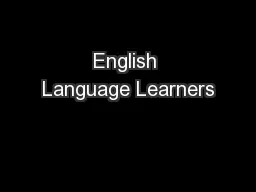

Diverse Learners Spotlight Presentation University of New England By Erin Dilla Challenges for English Language Learners Why Should Teachers Be Concerned about English Language Learners ID: 619289
Download Presentation The PPT/PDF document "English Language Learners" is the property of its rightful owner. Permission is granted to download and print the materials on this web site for personal, non-commercial use only, and to display it on your personal computer provided you do not modify the materials and that you retain all copyright notices contained in the materials. By downloading content from our website, you accept the terms of this agreement.
Slide1
English Language Learners
Diverse Learners Spotlight Presentation University of New England By: Erin Dilla Slide2
Challenges for English Language Learners
Why Should Teachers Be Concerned about English Language LearnersEnglish Language Learners (ELLs) are one of the fastest growing populations in the United States today. In 2008, English Language Learners made up about 10% of the enrolled K-12 students of our nation (Calderon et. al, 2011).
ELLs face many challenges academically, especially in reading. Academic achievement and graduation rates are lower for English Language Learners than that of native English-speaking students (Calderon et. al, 2011).
My Personal Experience
I have taught at Hope Rural School for about 20 years and have worked with 5 different grade levels, from Pre-K4- 4
th
grade. Our school population is about 95% ELLs, who receive free lunch. I have seen our students struggle academically, especially in reading and language arts.
Our school was founded to serve the needs of the children of migrant and immigrant workers 34 years ago. At that time, a group of concerned parishioners recognized that the local public school was not addressing the population of Guatemalan and Mexican students, who had moved to the small, farming community of Indiantown, FL.Slide3
Summary of ELL Articles
Vocabulary
knowledge is vital to reading success, and ELLs often have a disadvantage in this area.
Direct instruction of vocabulary is limited in schools at all levels.Academic vocabulary is more difficult for students than conversational vocabulary.
Effective strategies include teaching synonyms, activities that offer repetition, keeping a vocabulary log, and using illustrations.
(
Sibold
, 2011)
Academic English that is used in school is often more difficult than
conversational English.
Comparing, classifying, and problem solving require higher level language skills.
Teachers can create a classroom climate that encourages instructional conversation.
Classroom climate is important to support language development for ELLs.
(Williams, 2001)
Oral
reading fluency is frequently used as an indicator of reading proficiency.
Researchers evaluated 171 ELLs using 4 different assessment tools, measuring fluency and comprehension.
Word callers, who call out words when reading, struggle with comprehension.
Of the students evaluated, 15.8% were identified as word callers, which was a higher than expected number.
This study found a gap between oral reading fluency and comprehension with the ELLs evaluated.
(Quirk and
Beem
, 2012)
ELLs
is one of the fastest growing student populations in our country.
There has been disagreement of best practices between theories of English-only instruction and bilingual education.
Success for All (SFA) has been shown to be an effective school reform approach for ELLs.
Cooperative learning and interventions for students, professional development for teachers, and family support are keys to success.
(Calderon,
Slavin
, and Sanchez, 2011)Slide4
Synthesis
English Language Learners face many challenges in the classroom. Vocabulary instruction is a key component of reading, and this is an identified area of weakness for English Language Learners. If conversational language is easier to acquire, teachers may not realize that English Language Learners may be struggling more with challenging academic vocabulary. Also, research has shown that effective vocabulary instruction is an area that receives inadequate attention in both elementary and high schools (
Sibold
, 2011). If this is true, ineffective or limited vocabulary instruction could have a greater impact on reading achievement for English Language Learners. Teachers need training and support to best serve ELLs. To promote student literacy, teachers also need to respect students’ backgrounds and culture (Calderon et. al, 2011).Slide5
Critical Analysis
Reading achievement is critical to school success, but for English Language Learners, reading is often difficult. For years, educators have used oral reading fluency as a measure of reading achievement. Quirk and
Beem (2012) found that this indicator may not be as strongly connected and accurate for ELLs. If this is the primary measure of achievement, ELLs, who may be good “word callers” with little comprehension skills, may be overlooked in identification of reading problems (Quirk and
Beem, 2012). Schools must provide support for our ELLs. Calderon et. al (2011) tell us that significant gaps in achievement exist between English Learners and English proficient students, and that many teachers are not prepared to help ELLs succeed. Professional development for teachers is needed to ensure best practices are used to support every student. Also, teachers need to have an understanding of language development, from basic communicative language to academic language (Williams, 2001). Research has shown that effective vocabulary instruction is a key component for student success. Effective strategies for vocabulary instruction include using real objects, pictures, repetition, anchor words and cooperative groups (
Sibold
, 2011). A positive classroom climate and teachers using community building language help to foster academic progress for ELLs (Williams, 2001). Slide6
ConclusionSlide7
Discussion
In what ways does the reading instruction at your school foster vocabulary development, especially in learning academic language, for English Language Learners?
References
Calderon, M.,
Slavin
, R., & Sanchez, M. (2011). Effective Instruction for English Learners. Future of Children, 21(1), 103- 127.
Quirk, M., &
Beem
, S. (2012). Examining the Relations between Reading Fluency and Reading Comprehension for English Language Learners. Psychology In The Schools, 49(6), 539-553.
Sibold
, C. (2011). Building English Language Learners' Academic Vocabulary: Strategies and Tips. Multicultural Education, 18(2), 24-28.
Williams, J. A. (2001). Classroom Conversations: Opportunities To Learn for ESL Students in Mainstream Classrooms. Reading Teacher, 54(8), 750-57.